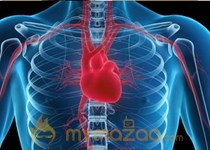During a heart attack, cardiac muscle cells die due to a lack of blood flow, but researchers at Stanford University have identified a protein that can be administered via a patch to help repair that damage.
“This finding opens the door to a completely revolutionary treatment,” senior study author Dr. Pilar Ruiz-Lozano, an associate professor of pediatrics at Stanford University, said in a news release. “There is currently no effective treatment to reverse the scarring in the heart after heart attacks.”
In a study published online Wednesday in the journal Nature, Ruiz-Lozano and her colleagues found that the protein Fstl1 played a key role in regenerating dead heart muscle cells in pigs and mice. They said a clinical trial involving the same therapy could begin as early as 2017.
They identified the protein by drawing from previous studies of zebrafish that suggested the epicardium— the inner layer of the pericardium that covers the heart— played a role in the healing process after a heart attack. In the animals, the team found that Fstl1, a protein secreted by the epicardium, contributed to the growth of cardiomyocytes, which are cardiac muscle cells.
To see how animals that suffered a heart attack would respond to the protein, they loaded a bioengineered patch with the protein and reintroduced it to the pigs’ and mice’s damaged tissue, according to the release. The patch consisted of acellular collagen and was altered to emulate the mechanics of the epicardium. Acellular collagen was an ideal material because it didn’t require the administration of an immunosuppressant, and its elasticity was similar to that of a fetal heart—shaping the perfect landscape for muscle regeneration, as new blood vessels also regenerated at the site of application. The collagen itself ended up being absorbed into the organ.
According to the news release, heart muscle cells regrew in the animals within two to four weeks after they received the patch. Ultimately the pigs and mice saw restored heart function.
“Many were so sick prior to getting the patch that they would have been candidates for heart transplantation,” Ruiz-Lozano said in the release.
Ruiz-Lozano and her team write in the paper that the next step is to test the patch on humans. About 735,000 Americans suffer from a heart attack each year, and the millions of annual worldwide deaths from heart attacks are predicted to triple by 2030.












